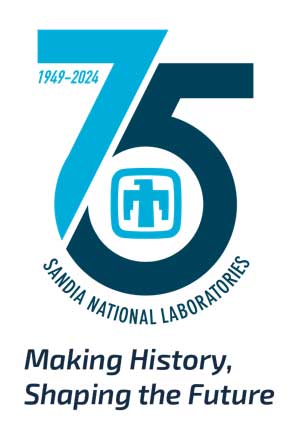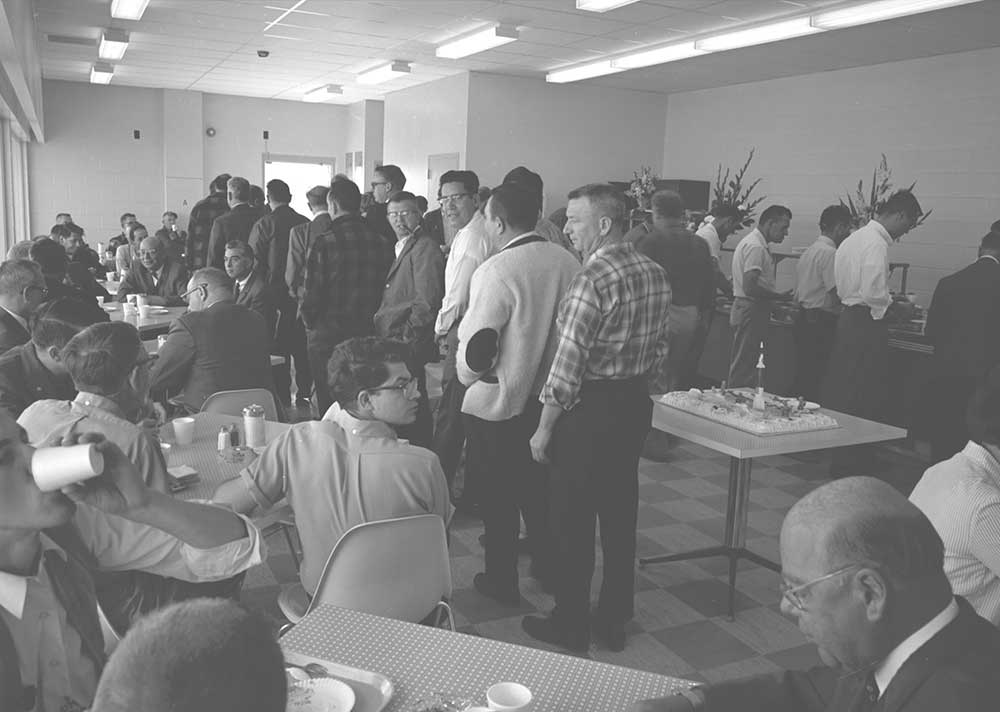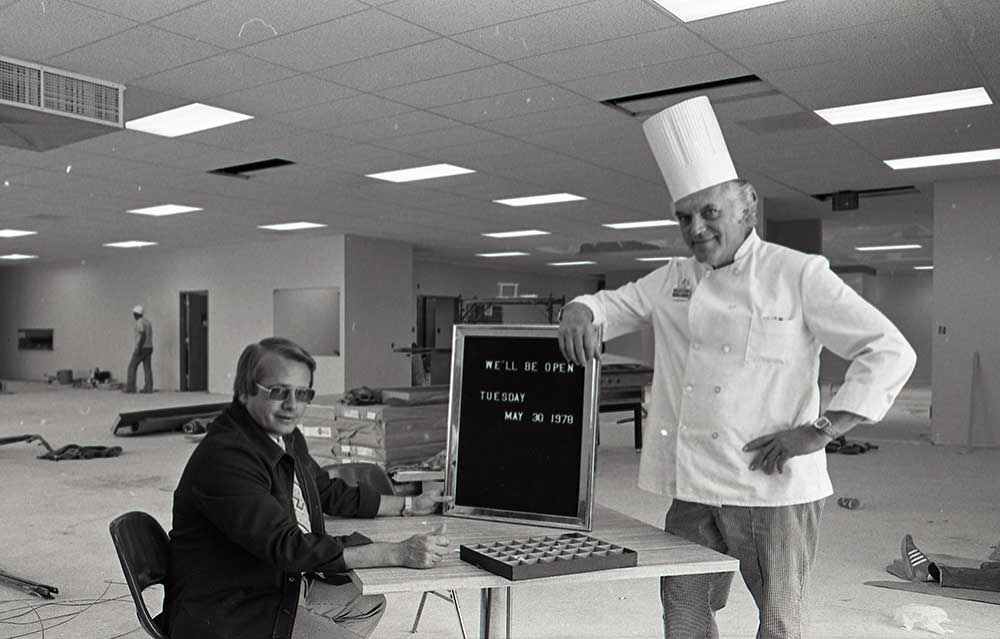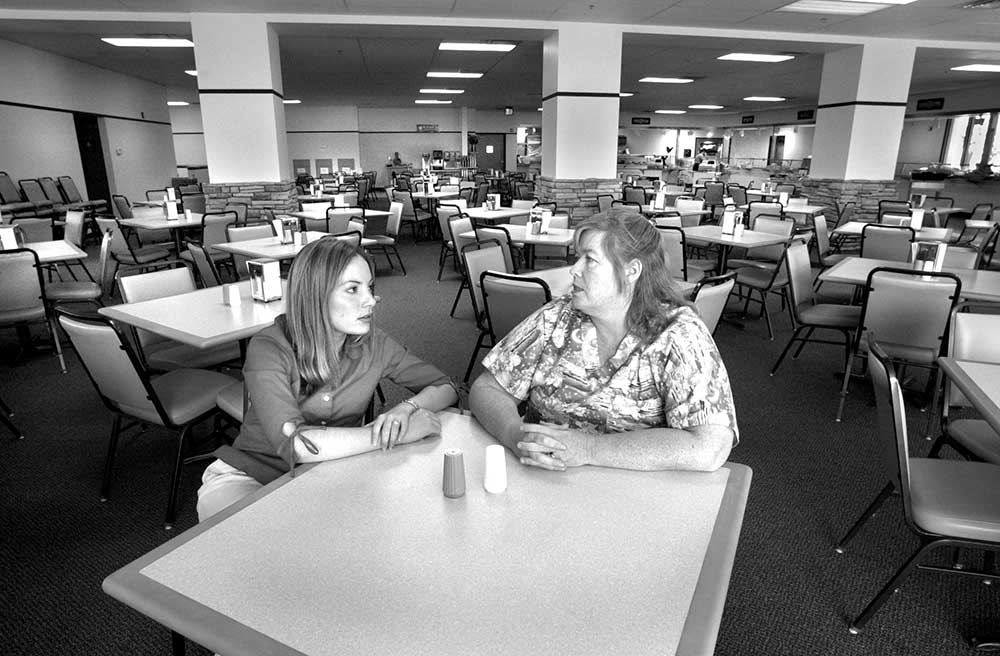Salad bars, hot plates and community


There’s a photo in the Sandia archives from 1945. It shows three men sitting around a lunch counter in what was at the time the newly established Z Division of Los Alamos. The photo is dated Sept. 7, 1945, five days after Japan signed the Instrument of Surrender on the USS Missouri, officially ending World War II.
We can’t say for certain what these men are talking about, but you can see at least two of them are smiling and the one whose back is to us is holding up two fingers so maybe, and I’m just inferring here, it has something to do with the news of the day.
Today our lunchrooms and counters look a little different than they did in 1945, and you’ll be hard pressed to find a sandwich plate for less than a buck. But for some of us, lunch is still a time to gather, have a laugh with friends and talk about the news of the day.
The lunchrooms
Based on that photo from 1945, there was a lunchroom in old Building 818. There may have been others, but there is no mention of any until 1951 when the Sandia Bulletin ran a short article about a new cafeteria going up in the tech area.
“A new lunchroom conveniently situated for Sandia Corporation employees working in the tech area will be opened soon. Located in the east end of Building 839, the cafeteria will serve lunches during the noon hour,” the piece read.
Hot soups, sandwiches, salads, desserts, milk, iced tea and coffee were among the offerings.
The Coronado Club cafeteria was also an option for Sandians, as membership was not required to enjoy lunch in the cafeteria. A photo from 1954 gives a snapshot of the menu and prices at the time. Cream of tomato soup for 20 cents a bowl, a sandwich plate for 60 cents, broiled hamburger steak with onion sauce and two sides for 85 cents, chile and pinto beans for 40 cents, a cup of coffee for 5 cents.
In 1953, the tech area got another cafeteria, this time in Building 880. Similar to 839, the cafeteria offered sandwiches and salads, but they added a rotating hot dish. While we don’t have a menu from that time, popular hot plates of the era included chicken à la king, beef stroganoff and Salisbury steak.

In 1964, the cafeteria in Building 839 got a makeover and according to a Lab News article that same year, “the bright, clean look of the recently redecorated facility in Bldg. 839 is enough to attract three course lunch gourmet diners and soup sippers alike.”
In 1967 and much farther south, Tech Area III got a brand-new cafeteria. Albeit smaller than the cafeterias before it, the 72-person-capacity café offered employees a complete lunch service plus a carryout selection of sandwiches and packaged snacks.
Thunderbird Café
What Sandians know today as Thunderbird Café opened in 1978, but back then it was just called 861 Café. As the Labs grew, so did the number of people trying to get lunch, especially around the noon hour and so in 1985, the 861 Café was expanded and remodeled, increasing the seating from 315 to 485. The redesign included the much-anticipated salad and sandwich bar. At that time the salad bar cost 15 cents an ounce and sandwiches were 35 cents an ounce. For context, a pound of salad would have cost about $2.40 and an eight-ounce sandwich would come in at $2.80.

In 2000, 861 Café got a new look and a new name. The Benefits Department sponsored a “name the cafeteria” contest and received more than 500 submissions, among those were Alimentary Particles, Atomic Pit, Combustion Cafeteria, Giga Bites, Pie-R-Square and Quantum Café. But Thunderbird Café took the prize. The updates included a new kitchen, new serving stations, new food items and a “21st century food-court ambience.”
Although, according to Labs’ historian Rebecca Ullrich, the new Thunderbird Café brought some unwelcome changes as the $1 bean-and-cheese burritos were no more.
“You don’t mess with $1 burritos,” Rebecca said. “There was a huge pushback and a lot of complaining.”
Today you can still find a burrito at the Thunderbird Café but, as with everything, it’s not as cheap as it used to be. For a little over eight bucks you can get a burrito with protein, rice, beans, chile, cheese and garnish.

During the COVID-19 pandemic, the cafeteria remained open, although given the reduction in people working on-site, the menu was limited. However, what they didn’t sell in food, they made up for in essentials.
“The Corner Store up front sold grab-and-go meals and had a preorder option, but they also offered prepared meals for pickup, and they sold household supplies, like toilet paper, flour and someone told me they even had yeast,” Rebecca said. “They really hung in there and stepped up to serve the needs of our community at that time.”
These cafeterias, lunchrooms, cafés, whatever we want to call them, it’s the food that brings us there but it’s the community that makes us stay. It’s a place we can gather, catch up on the news of the day, collaborate on new ideas, celebrate milestones and if we’re lucky, have some laughs around a counter, while enjoying a reasonably priced burrito.

